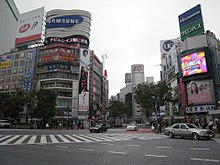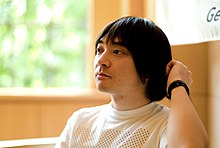Shibuya-kei
| Shibuya-kei | |
|---|---|
 Shibuya Crossing, 2007 | |
| Native name | 渋谷系 |
| Stylistic origins | |
| Cultural origins | 1990s, Shibuya, Japan |
| Typical instruments | |
| Other topics | |
Shibuya-kei (Japanese: 渋谷系, "Shibuya style") is an eclectic form of pop music[1] and aesthetic[6] that flourished in the mid to late 1990s.[3] Emerging as Japanese retail music from the Shibuya district of Tokyo,[4] artists purveyed a cut-and-paste style that was inspired by previous genres based on kitsch, fusion, and artifice.[7] The genre was strongly influenced by 1960s culture and Western pop music,[1] especially the orchestral domains occupied by producers Burt Bacharach, Brian Wilson, Phil Spector, and singer Serge Gainsbourg.[8]
Unlike other Japanese music scenes, its audiences did not necessarily cross over into anime fandoms, but rather indie pop enthusiasts. This was partly because many of its bands were distributed in the United States through major indie labels like Matador and Grand Royal.[3] Flipper's Guitar, a duo led by Kenji Ozawa and Keigo Oyamada (Cornelius), formed the bedrock of the genre, influencing all of its groups, but the most prominent Shibuya-kei band was Pizzicato Five, who fused mainstream J-pop with a mix of jazz, soul, and lounge influences. Shibuya-kei peaked in the late 1990s and declined after its principal players began moving into other music styles.[9]
Background and influences
The term "Shibuya-kei" comes from Shibuya (渋谷), one of the 23 special wards of Tokyo known for its concentration of stylish restaurants, bars, buildings, record shops, and bookshops.[10] In the late 1980s, the term "J-pop" was formulated by FM radio station J-Wave as a way to distinguish Western-sounding Japanese music (a central characteristic of Shibuya-kei) from exclusively Euro-American music.[10] In 1991, HMV Shibuya opened a J-pop corner which showcased displays and leaflets that highlighted indie records. It was one of those displays that coined "Shibuya-kei".[11]
The upper middle-class, privately educated rich kids who frequented these [Shibuya record] stores bought loads of imported records from the UK and esoteric reissues of all kinds, then created music that was a portrait of themselves as exquisitely discerning consumers.
At the time, Shibuya was an epicenter for Tokyo fashion, nightlife, and youth culture[13] with a cluster of record shops like Tower Records and HMV, which housed a selection of imports, as well as fashionable record boutiques.[12] British independent record labels such as él Records and the Compact Organization had been influences on the various Japanese indie distributors,[14] and thanks to the late 1980s economic boom in Japan, Shibuya music shops could afford to stock a wider selection of genres.[10]
Shibuya in the '90s is just like Haight-Ashbury in the '60s. The young people there are always thinking about how to be cool.
Musicologist Mori Yoshitaka writes that popular groups from the area responded with their "eclectically fashionable hybrid music influenced by different musical resources from around the world in a way that might be identified as postmodernist ... they were able to listen to, quote, sample, mix, and dub this music, and eventually create a new hybrid music. In other words, Shibuya-kei was a byproduct of consumerism".[10] Journalist W. David Marx notes that the musicians were less interested in having an original sound than they were about having a sound that reflected their personal tastes, that the music "was literally built out of this collection process. The 'creative content' is almost all curation, since they basically reproduced their favourite songs, changing the melody a bit but keeping all parts of the production intact."[16]
Specific touchstones include the French yé-yé music of Serge Gainsbourg,[nb 1] the orchestral pop of Van Dyke Parks and the Beach Boys' Brian Wilson,[4] the lounge pop of Burt Bacharach,[1] and the sunshine pop of Roger Nichols and the Small Circle of Friends.[2] Wilson was romanticized a mad genius experimenting in the recording studio, and Phil Spector's Wall of Sound was emulated not for its denseness, but for its elaborate quality.[15] From él Records, Louis Philippe was heralded as the "godfather" of the Shibuya sound around the time he released the Japan-only albums Jean Renoir (1992) and Rainfall (1993).[17] Reynolds adds that Postcard Records and "the tradition of Scottish indie pop it spawned was hugely admired, and there was a penchant for what the Japanese dubbed ‘funk-a-latina’: Haircut 100 ..., Blue Rondo à la Turk, Matt Bianco. The composite of all these innocuous and already distinctly ersatz sources was a cosmopolitan hybrid that didn’t draw on any indigenous Japanese influences."[16]
Development and popularity

Flipper's Guitar, a duo led by Kenji Ozawa and Keigo Oyamada (also known as Cornelius), were active before the term was coined. They were foundational to the genre, influencing all of its groups.[18] By 1993, the definition of "Shibuya-kei" was crystallized,[6] with artists indulging in a cut-and-paste style that was inspired by previous genres based on kitsch, fusion, and artifice.[7] In the West, the development of chamber pop and a renewed interest in cocktail music was a remote parallel.[19][nb 2] According to Reynolds: "What was really international was the underlying sensibility. ... The Shibuya-kei approach was common to an emerging class of rootles cosmopolitans with outposts in most major cities of the world ... known pejoratively as hipsters."[21] Eventually, the music of Shibuya-kei groups and their derivatives could be heard in virtually every cafe and boutique in Japan. Reynolds references this as a "problem with ... [its] model of elevated consumerism and curation-as-creation ... Once music is a reflection of esoteric knowledge rather than expressive urgency, its value is easily voided."[22]
After Oyamada went solo, he became one of the biggest Shibuya-kei successes.[12] Although his debut "The Sun Is My Enemy" only peaked at No. 15 on Japanese singles charts, writer Ian Martin calls it a "key track" that helped define Shibuya-kei.[5] His 1997 album Fantasma is also considered one of the greatest achievements of the genre.[21][18] Oyamada landed praise from American music critics, who called him a "modern day Brian Wilson" or the "Japanese Beck".[8] Marx described the album as "an important textbook for an alternative musical history where Bach, Bacharach, and the Beach Boys stands as the great triumvirate."[18]
The most prominent Shibuya-kei band was Pizzicato Five, who fused mainstream J-pop with a mix of jazz, soul, and lounge influences, reaching a commercial peak with Made in USA (1994).[13] As the style's popularity increased at end of the 90s, the term began to be applied to many bands whose musical stylings reflected a more mainstream sensibility. Although some artists rejected or resisted being categorized as "Shibuya-kei," the name ultimately stuck, as the style was favoured by local businesses, including Shibuya Center Street's HMV Shibuya, which sold Shibuya-kei records in its traditional Japanese music section. Increasingly, musicians outside Japan, such as Britain's Momus, France's Dimitri from Paris, and the US artists Natural Calamity and Phofo are labelled Shibuya-kei.[citation needed]
According to Momus, although Shibuya-kei continues to influence many musicians, the genre remains "dead" as of 2015, explaining that the subculture had a lot to do with the area itself; "Shibuya today is just an overblown shopping district, summed up for me by the disappointing Shibuya Hikarie center".[23]
List of artists
Neo-Shibuya-kei
Notes
- ^ Particularly "Yume Miru Shanson Ningyō", the Japanese version of the France Gall big hit Poupée de cire, poupée de son,[citation needed]
- ^ Like Shibuya-kei, chamber pop foregrounded instruments like strings and horns in its arrangements.[19] AllMusic notes that although chamber pop was "inspired in part by the lounge-music revival", there was a "complete absence of irony or kitsch".[20]
- ^ The band's Sugar Yoshinaga contests the labels and believes the group has a different sound.[24]
References
- ^ a b c d e f g Anon. (n.d.). "Shibuya-Kei". AllMusic.
- ^ a b c d e f Reynolds 2011, p. 168.
- ^ a b c d e Ohanesian, Liz (April 13, 2011). "Japanese Indie Pop: The Beginner's Guide to Shibuya-Kei". LA Weekly.
- ^ a b c d e f Joffe, Justin (June 13, 2016). "The Day J-Pop Ate Itself: Cornelius and the Timeless Freakiness of 'Fantasma'". The Observer.
- ^ a b c d e Martin, Ian (August 28, 2013). "Twenty years ago, Cornelius releases the track that defined Shibuya-kei". The Japan Times.
- ^ a b McKnight 2009, p. 451.
- ^ a b Tonelli 2004, p. 4.
- ^ a b c Lindsay, Cam (August 4, 2016). "Return to the Planet of Cornelius". Vice.
- ^ a b Michael, Patrick St. (June 11, 2016). "Cornelius: Fantasma Album Review". Pitchfork.
- ^ a b c d Yoshitaka 2009, p. 225.
- ^ Onishi 1998, p. 482, coined after an HMV Shibuya J-pop display; McKnight 2009, p. 451, HMV Shibuya's J-pop corner opened in 1991
- ^ a b c d e f g h Reynolds 2011, p. 166.
- ^ a b Alston, Joshua (June 1, 2015). "Pizzicato Five stripped disco to its barest essentials and turned it Japanese". The A.V. Club.
- ^ Onishi 1998, p. 482.
- ^ a b Walters, Barry (November 6, 2014). "The Roots of Shibuya-Kei". Red Bull Music Academy.
- ^ a b Reynolds 2011, p. [page needed].
- ^ Evans, Christopher. "Louis Philippe". AllMusic.
- ^ a b c Hadfield, James (July 24, 2016). "Keigo Oyamada sees U.S. 'Fantasma' tour as a good warm-up to new Cornelius material". The Japan Times.
- ^ a b Tonelli 2004, p. 3.
- ^ "Chamber pop". AllMusic.
- ^ a b Reynolds 2011, p. 169.
- ^ Reynolds 2011, p. 170.
- ^ a b c d e Fisher, Devon (March 10, 2015). "Momus honors music's eccentrics on 'Turpsycore'". The Japan Times.
- ^ Kikuchi, Daisuke (July 22, 2014). "Buffalo Daughter calls on some 'konjac-tions' for its newest album". The Japan Times.
- ^ Se-ho B, Kim (February 11, 2014). "Catching Up With Cibo Matto". The Harvard Crimson.
- ^ Martin, Ian (July 10, 2013). "C86 sound jangles on in the Japanese indie scene".
- ^ St. Michel, Patrick (September 2, 2014). "Dustin Wong and Takako Minekawa let their imaginations run wild on new album". The Japan Times.
- ^ Ashcraft, Brian (June 28, 2011). "These Ladies Know the Sweet Smell of Success". Kotaku.
- ^ St. Michel, Patrick (September 29, 2014). "HNC - "Southern Fruitas"". Pitchfork.
- ^ St. Michel, Patrick (August 9, 2015). "Even if you don't see Yasutaka Nakata at Summer Sonic, you'll probably hear him". The Japan Times.
Bibliography
- McKnight, Anne (2009). "Shibuya-Kei". The Encyclopedia of Contemporary Japanese Culture. Taylor & Francis. ISBN 978-0-415-48152-6.
{{cite book}}: Invalid|ref=harv(help) - Onishi, Koji (1998). "Shibuya-Kei (Shibuya Sound) and globalization". In Mitsui, Tōru (ed.). Popular Music: Intercultural Interpretations. Graduate Program in Music, Kanazawa University. ISBN 978-4-9980684-1-9.
{{cite book}}: Invalid|ref=harv(help) - Reynolds, Simon (2011). Retromania: Pop Culture's Addiction to Its Own Past. Farrar, Straus and Giroux. ISBN 978-1-4299-6858-4.
{{cite book}}: Invalid|ref=harv(help) - Tonelli, Christopher (2004). Shibuya-kei? O-kei Desu!: Postmodernism, Resistance, and Tokyo Indie Culture. University of California, San Diego.
{{cite book}}: Invalid|ref=harv(help) - Yoshitaka, Mori (2009). "Reconsidering Cultural Hybridities". In Berry, Chris; Liscutin, Nicola; Mackintosh, Jonathan D. (eds.). Cultural Studies and Cultural Industries in Northeast Asia: What a Difference a Region Makes. Hong Kong University Press. ISBN 978-962-209-975-3.
{{cite book}}: Invalid|ref=harv(help)
External links
- Keikaku - Independent and little known Japanese Artist profiles, reviews, interviews and articles in English.
- Shibuya-kei on CDJournal.com Template:Ja

